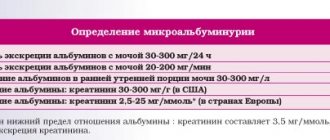Amount of urine
The normal amount of urine of a healthy person (daily diuresis) directly depends on the patient’s age and varies in the range from 1 to 2 liters. There are also such concepts as daytime and nighttime diuresis. Normally, the amount of urine excreted during the day is greater than at night. If the amount of night urine is higher, this may indicate the presence of pathology associated with cardiac decompensation and cystopyelia.
If you notice a large amount of daily urine, then do not rush to diagnose yourself - perhaps you are drinking too much water (foods with a high water content, such as watermelon or cantaloupe). If the diet has not changed, then a sharp increase in the amount of daily urine, called polyuria, may indicate the presence of pathology (nervous excitement, diabetes (sugar and insipidus), kidney disease, pyelonephritis).
A small amount of daily urine is observed with profuse sweating, poisoning (diarrhea and vomiting). At the same time, body weight increases and swelling of the body increases.
Speaking about reducing the amount of urine per day, two conditions can be distinguished: oliuria and anuria.
- Reducing the amount of daily urine:
- Oliruria - the amount of daily urine less than 500 ml per day
- Anuria - the amount of daily urine less than 100 ml per day
- Anuria, in turn, happens:
- prerenal (appears with heavy bleeding, severe diarrhea)
- renal (associated with pathology in the kidneys and appears in acute renal failure caused by acute nephritis, kidney necrosis)
- obstructive (appears due to blockage of the ureters with stones or pressure on them from bladder tumors)
Also worth noting is the concept of ischuria - urinary retention due to the inability to urinate independently (adenoma, inflammatory diseases or prostate cancer).
Indications for 24-hour urine analysis
This study is prescribed by a doctor to identify many indicators. The presence and mass of the following substances are most often determined: protein, glucose, oxalates and metanephrines. Since the study also establishes quantitative indicators, the patient must know exactly how to collect a daily urine test. Detection of protein in the material is necessary for diabetes mellitus, the risk of developing coronary heart disease, nephropathy and chronic renal failure, as well as when taking certain medications. Detection of glucose in urine is prescribed for diagnosing diabetes mellitus, pathology of the adrenal glands and thyroid gland, pancreatic tumors and pancreatitis. Metanephrines are detected in diseases of the adrenal glands, oxalates - in diabetes mellitus, renal failure, urolithiasis and other diseases.
How to prepare for analysis
To reduce the risk of incorrect interpretation of results, you need to know how to correctly collect daily urine for analysis. The doctor who ordered the testing should tell the patient what rules need to be followed during the collection of biomaterial. 3 days before collecting biomaterial, the following recommendations must be followed.
It is necessary to exclude from the diet foods that can color urine. This primarily applies to beets, carrots and berries. Limit consumption of fatty and fried foods. You should also refrain from excessive consumption of salt and sugar; you should drink at least 2 liters of filtered water throughout the day.
You should stop using medications. If you cannot do without taking medications, you must notify your doctor, who will interpret your daily diuresis. Since such a biochemical analysis will require urine collection throughout the day, the patient is advised to take a day off and avoid traveling.
To properly donate urine, you need to adhere to these rules. First you need to prepare a sterile container in which the collected material will be stored. Its volume must be at least 2 liters. It is advisable that the container is tightly closed. The best option is to purchase a special sterile plastic container, which is sold in every pharmacy.
The patient needs to record the start time of collecting biomaterial so that exactly one day passes. If the first collection of biomaterial will be carried out at 8 am, then the last portion of urine should be taken no later than this time.
Before the procedure, it is necessary to perform genital hygiene without using soap and gels with fragrances. The only thing that can be used is a weak solution of potassium permanganate or furatsilin.
The first portion of urine after waking up is not collected, but the time of emptying the bladder is recorded. It is recommended to store the container with urine in the refrigerator on the middle shelf, which will help avoid freezing. The lid must be tightly closed.
On the day the sample is submitted, the contents of the container must be thoroughly mixed and 150–200 ml poured. sample into a sterile container. These rules must be followed by all patients, regardless of age, gender and health status. They also need to be followed during pregnancy.
How long the analysis is done and when the results are ready depends on the type of laboratory. In most cases, the transcript of the analysis is prepared in no more than 2 days, after which a form with the results is given to the patient.
Normal in healthy people
The volume of urine excreted during the current day depends on factors such as a person’s age, gender, type of liquid drunk (alcohol, carbonated drinks, diuretic decoctions, compotes), the ratio of hours of rest and active physical labor. How much urine should be excreted in 24 hours in a person who has no underlying health conditions? In men, the condition of the genitourinary system is considered normal if, according to the results of daily collection of biological material, the amount of urine does not exceed 2 liters.
Normal functioning of the excretory organs in women is when no more than 1.6 liters of urine are released during the day. Depending on the individual characteristics of the body, these normal indicators may deviate slightly in one direction or another, but no more than 100-200 milliliters
It is important to remember that the total volume of urine should also be at least 500 ml per day. Lower numbers indicate that the excretory system of an adult man or woman is not normal
In addition, the following conditions are of great importance:
- the volume of fluid drunk over the last 24 hours;
- body weight of a man or woman who is taking a daily diuresis test;
- ambient temperature (if people are in a hot or stuffy room, sweating increases and the amount of urine released decreases);
- a diet consisting of foods and drinks that have diuretic properties and stimulate kidney function (sauerkraut, apples, grapes, watermelon, hot spices, rosehip decoction).
Daily urine protein content
Normal heart rate in children and adults
Often, closer to the end of pregnancy, a woman begins to show signs of gestosis - late toxicosis, especially if she was previously diagnosed with various chronic diseases. In such cases, doctors immediately check the daily protein in the urine. Visually, you can notice a change in color and transparency: the urine in the jar is cloudy and there is sediment.
The protein norm is up to 0.03 g/l. What does increased daily protein indicate? First of all, doctors suspect that the kidneys are not doing their job. The reason for this may be a heavy load during pregnancy, especially if the woman has previously suffered from chronic pyelonephritis. The dose of protein increases with inflammation of the urinary tract, but this phenomenon is temporary. Persistent presence of protein, poor analysis - this situation should alert the doctor, and the woman will be offered hospitalization in order to restore kidney function and maintain pregnancy. Sometimes an increase in protein indicates that the initial symptoms of pancreatitis are occurring.
How much urine do you need to take a protein test? Usually they use a sample from daily urine, less often - all urine if they do a Zimnitsky test.
In addition to protein and sugar content, doctors are interested in indicators such as:
- color;
- transparency;
- density.
Each of them has a lot to say to an experienced specialist. The woman’s task is not to panic, even if abnormalities are detected, but to calm down and trust her doctor. He will make a decision, prescribe a suitable diet and prescribe medications if necessary. Today you can successfully bring your pregnancy to a successful conclusion even in the presence of serious pathologies, so you should expect the best and follow all the doctor’s instructions.
Current video
Preparing for analysis
There are a number of requirements to prepare for analysis. Following these recommendations will allow you to obtain more reliable results. The patient is required to:
- Eliminate from your diet 12 hours before the start of the study foods such as carrots and beets that affect the color of urine. Also during this period, alcohol, spicy and salty foods, vitamins and diuretics are not allowed (during pregnancy, vitamin complexes are allowed after consultation with the doctor);
- Ensure the cleanliness of the genitals when urinating in order not to contaminate the test samples. For this reason, it is not recommended to conduct a 24-hour urine test for women during the menstrual cycle, as the results may be unreliable due to blood entering the urine. There are no such contraindications for research during pregnancy;
- Stock up on special utensils that allow you to properly collect, store and donate urine. The best option would be to purchase a specialized container (2.0–2.7 l) with a wide neck and a comfortable textured handle. If this is not possible, you can use ordinary 3-liter glass jars, although they do not have sufficient characteristics of an assembly container. The main requirement for collection containers is complete tightness and preliminary disinfection.
Daily diuresis of a pregnant woman
During pregnancy, a woman’s body receives a double load.
An increase in the volume of circulating fluid leads to an increase in the need for water support.
This can lead to fluid accumulation in a woman's body.
Because of this, swelling develops.
This forces a woman’s kidneys to work harder.
The volume of daily urine increases.
On average, the figure is 60–80% of fluid consumed.
This is due to fetal pressure on the bladder.
https://youtube.com/watch?v=dMEvfFNEvwQ
The daily volume of urine indicates several pathological forms:
- Polyuria means a condition when the volume of daily urine output exceeds 3 liters. Symptoms of the nature when the concentration of vasopressin, a hormone, otherwise called antidiuretic hormone, is exceeded. This is observed in people suffering from diabetes or problems with the concentrating ability of the kidneys.
- Oliguria – a condition that means a sharp decrease in the amount of fluid during daily urination. The volume does not exceed 500 ml of liquid.
- Anuria – the amount of urine excreted per day decreases to 50 ml. Such a decrease indicates serious kidney pathologies, meningitis, vulvitis, spinal shock, or the appearance of stones in a person’s urinary tract.
- Nocturia is a type of daily diuresis in which more fluid comes out at night than during the day. At the same time, the rate of urine per day in adults with nocturia will not decrease, but remains normal.
Preparation for collecting material
To obtain the most reliable examination results, you must follow some rules before donating urine:
- on the day of the analysis, you must stop using diuretics, consuming diuretic products, as well as any drugs that have a direct or indirect effect on kidney function,
- stick to your usual fluid intake regimen,
- do not change your usual diet.
To avoid distortion of analysis data, it is necessary to prevent the influence of random factors and strictly follow the rules for collecting urine. Be sure to follow all the rules of the preparation stage for analysis:
- During the day you need to eliminate alcohol and coffee, give up not only medications, but also vitamin complexes.
- Women should not have the test done during their period. Urine collection during menstruation is carried out in extreme cases, but the data obtained in any case will be inaccurate.
- Collect urine in a special container - it is sterile and can be found in any pharmacy. It is recommended to use small containers and then pour the urine into the general container.
- It is not necessary to sterilize the containers; just wash them thoroughly.
Urine collection according to Zimnitsky in pregnant women
Urine according to Zimnitsky during pregnancy is most often prescribed for suspected kidney problems.
When prescribing this analysis, the rules for collection and delivery are different: collection occurs at strictly defined hours, and portions are not mixed, each is stored in its own jar. All jars are delivered to the laboratory.
Prepare 8 containers. You should go to the toilet for the first time at 6 a.m.; you do not need to collect this portion. The time of first urination should be recorded. Then the scheme is as follows: the day is divided into 8 time intervals of 3 hours. All urine released within 3 hours is collected in one container.
| 1 | 9:00-12:00 |
| 2 | 12:00-15:00 |
| 3 | 15:00-18:00 |
| 4 | 18:00-21:00 |
| 5 | 21:00-24:00 |
| 6 | 00:00-03:00 |
| 7 | 03:00-06:00 |
| 8 | 06:00-09:00 |
Normally, about a third of the daily urine should be excreted at night. If one or more containers remain empty, they are also taken to the laboratory.








